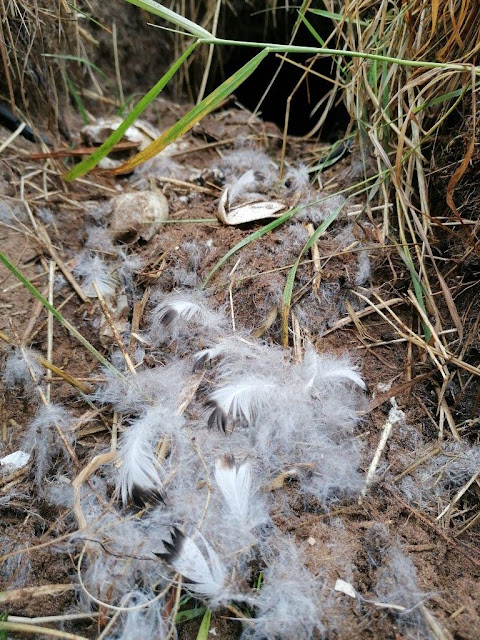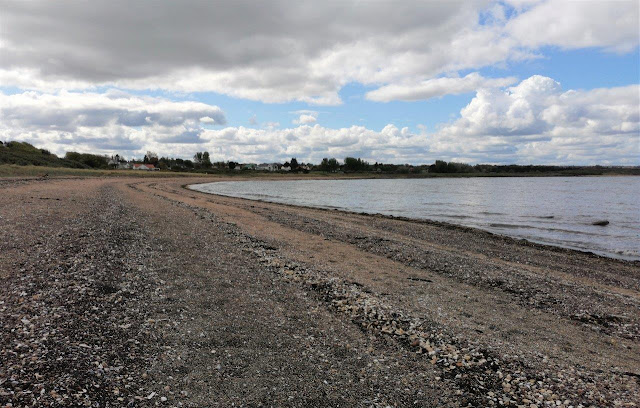


The characteristic species inhabitating the buckthorn on the Bents include a number of warbler species, easily detectable by their frequent song (particularly after first arrival in spring) including Willow Warbler, Chiffchaff, Blackcap and Whitethroat:

Also several seed-eaters including Linnet (male above), Tree Sparrow, Bullfinch, Goldfinch and Reed Bunting, the tit family including Long-tailed Tits; Nuthatch, Great Spotted Woodpecker and Sparrowhawk in Fernyness Wood, and many others.
With a telescope Velvet and Common Scoter can normally be seen offshore, along with Eider (duckings seen), Long-tailed Duck, Red-breasted Merganser and Red-throated Diver, and seabirds like Gannet and Fulmar, and the auks (Puffins are very regular offshore, hurrying back to colony with food in summer months) while many species of wader and Grey Heron feed on the shore, with terns in season, mainly concentrated at Port Seton (previous blog) - where Gadwall can now reliably be seen on the burn:
Scarcer species noted during the period included [White-billed Diver], Little Egret; Red-necked, Slavonian & Great Crested Grebes; Whooper Swan, Brent Goose (pale-bellied) & Surf Scoter; a pair of breeding plumage Goosander in May; Hobby; Quail; Grey Plover, Purple Sandpiper, Whimbrel & Snipe; several Mediterranean Gulls (1st-sum, 2nd-sum & ads); Little & Arctic Terns; Whinchat & Stonechat; [the famous Rose-coloured Starling]; and Grasshopper, Sedge & Garden Warblers, and Lesser Whitethroat (song), [plus a one-day visit by a rare Marsh Warbler (4th for Lothian if accepted)], []=found by others - also a pair of Garganey, Red Kite, Roseate Terns, a Cuckoo (heard), singing Reed Warbler and two Redstarts which I missed; some species seemed to be exploiting the generally reduced disturbance from the lockdown, including Grey Partridge, Stock Dove and Skylark on/over the golf course, and a pair of Shelduck frequented Longniddry shore and Gosford Sands - drake in first image below, fresh from attacking some unsuspecting drake Eiders, the lady bird next near her nest burrow - down and egg shells were found on 11 June confirming Shelduck had indeed bred here, probably for the first time since at least 1991!




Other breeding confirmations included Herring Gull on two roofs at Port Seton shops, Treecreeper with a family huddled in a tree fork, Long-tailed Tits, Tree Sparrow and Bullfinch, Sparrowhawks were regularly seen taking prey into a nesting area and also Kestrel; juvenile Tawny Owls were located at both ends of the village and Great Spotted Woodpecker was seen taking food to Fernyness Wood. Hopefully a good number more species will still be confirmed once juveniles start to roam.
Mammals are mainly rabbits, grey squirrels are fairly scarce but pipistrelle bats are widespread at dusk; there's a fox den at the Seton Burn and one was hurrying over the golf course early in #lockdown; with a telescope you can see the Common Seals which often haul out at Craigielaw, 18 in photo below, and a Grey Seal has a favourite rock to haul out at Seton Sands.


In the course of same visits a huge amount of litter was also cleared from the Bents and verges, 2-3 bags per day, so over 200 altogether (~10,000 individual items), spanning bagged dog waste (many hundreds), cans and drinks bottles, increasing amounts of wet wipes, gloves and face masks, and polystyrene fast food boxes, the older ones of which are now breaking down (Tweet); example of litter *just from the verge* and *just for one day* between Seton Sands and Longniddry Bents (less than a mile) is shown below:

The oldest verified item found was a packet of Monster Munch with expiry date on 4 Sept 1993 - complete with a little story about fishing a packet out of the sea - this one barely decayed in 27 years out in the Bents, the date had rubbed off on some older ones.
Here's a Herring Gull tackling a KFC cup which it believes should be edible:
No response from the company to being tagged in the Tweet. Others have proposed a great idea to resolve this, printing car registration numbers on take away packaging - some obvious snags though it may make some difference, but it seems there is no appetite for it from the big multinationals which exploit us and our environment, McDonalds, KFC and the rest. Seems odd to me - every single day they have a direct negative impact on my life, as I clear the waste they generate which spoils our coast and environment, knowing they could take simple steps to start to address it, but they choose not to. Clearly they cater for a customer base who generally could not care less and thus feel no obligation to do anything :(
Parking tickets were commonly found, as shown top left, some motorists seem to believe that because the car parks are shut they can legitimately park on the double yellows, or in the layby by c/p 2, wardens don't agree (211 parking notices issued wknd 30-31 May). Another notable feature is that a lot of items are half drunk/eaten - the Lucozade bottles above were nearly full many of the fish & chips the same, clearly even in the economic crisis post-COVID there are still many who are so well off they can chuck away most of what they buy. The Courier featured "533 laughing gas canisters" and "hundreds of empty alcohol bottles" but failed to mention that these were all new, the previous batches had already been cleared by stretched rangers and council workers, plus volunteers. Another shocking find by the caravan park this photo - what kind of person spends a week at a holiday camp and when leaving goes to the local beach, straight past the signs about plastic waste by the community picnic tables, and stuffs a huge black bag of rotting food waste behind the bushes - which by following day has already been ripped by scavengers and dispersed by the wind? Do they really have no bins or recycling in caravan parks? Clearly another who has plenty to spare, half eaten fast food, dozens of fizzy drink tins, cigarette packets, dog food tins and cleaning equipment. And this is what you may encounter after a "party" gathering, several hundred bottles and cans in one small part of the beach:
 A final warning on traffic and road safety - those of us who live in the village are familiar with the sound of motorbikes and souped-up cars using the coast road as a race track but this makes crossing the main road to the beach pretty hazardous, especially for those with children - and there have been two fatalities at Seton Sands in recent years - this problem has been even worse during lockdown though police have stepped up patrols.
A final warning on traffic and road safety - those of us who live in the village are familiar with the sound of motorbikes and souped-up cars using the coast road as a race track but this makes crossing the main road to the beach pretty hazardous, especially for those with children - and there have been two fatalities at Seton Sands in recent years - this problem has been even worse during lockdown though police have stepped up patrols.
Here's the rest of the landscape photos taken in many different weather conditions, mostly in evenings, following a progression east to west:

















































































































